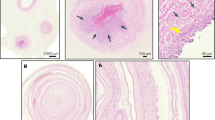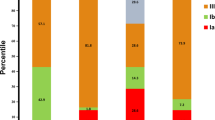Abstract
Objective:
The aim of this study was to identify risk factors for early-onset group B Streptococcus (EOGBS) disease in neonates of mothers with negative antenatal screening.
Study Design:
We performed a retrospective cohort study of neonates born to mothers with negative antenatal GBS screening between 2002 and 2012. Our primary outcome was EOGBS infection. We used multivariable logistic regression to assess factors associated with EOGBS.
Results:
EOGBS was confirmed in 492 of the 179 818 neonates that met the study inclusion criteria. Risk factors for EOGBS included black race (reference: white, odds ratio (OR) =1.81 (95% confidence interval: 1.43, 2.31)), maternal age <18 years (reference: >35 years, OR=2.63 (1.54, 4.51)) and maternal age 18 to 35 years (reference: >35 years, OR=1.94 (1.30, 2.88)).
Conclusion:
Maternal age <18 years and black race were the strongest predictors of EOGBS. Further research investigating contributors to the discordance between screening results and neonatal outcomes in these populations is needed.
This is a preview of subscription content, access via your institution
Access options
Subscribe to this journal
Receive 12 print issues and online access
$259.00 per year
only $21.58 per issue
Buy this article
- Purchase on Springer Link
- Instant access to full article PDF
Prices may be subject to local taxes which are calculated during checkout

Similar content being viewed by others
References
Van Dyke MK, Phares CR, Lynfield R, Thomas AR, Arnold KE, Craig AS et al. Evaluation of universal antenatal screening for group B streptococcus. N Engl J Med 2009; 360 (25): 2626–2636.
Trends in perinatal group B streptococcal disease—United States, 2000–2006. MMWR Morb Mortal Wkly Rep 2009; 58 (5): 109–112.
Phares CR, Lynfield R, Farley MM, Mohle-Boetani J, Harrison LH, Petit S et al. Epidemiology of invasive group B streptococcal disease in the United States, 1999-2005. JAMA 2008; 299 (17): 2056–2065.
Stoll BJ, Hansen NI, Sanchez PJ, Faix RG, Poindexter BB, Van Meurs KP et al. Early onset neonatal sepsis: the burden of group B Streptococcal and E. coli disease continues. Pediatrics 2011; 127 (5): 817–826.
Heath PT, Balfour G, Weisner AM, Efstratiou A, Lamagni TL, Tighe H et al. Group B streptococcal disease in UK and Irish infants younger than 90 days. Lancet 2004; 363 (9405): 292–294.
Koenig JM, Keenan WJ . Group B streptococcus and early-onset sepsis in the era of maternal prophylaxis. Pediatr Clin North Am 2009; 56 (3): 689–708.
Puopolo KM, Madoff LC, Eichenwald EC . Early-onset group B streptococcal disease in the era of maternal screening. Pediatrics 2005; 115 (5): 1240–1246.
Pinto NM, Soskolne EI, Pearlman MD, Faix RG . Neonatal early-onset group B streptococcal disease in the era of intrapartum chemoprophylaxis: residual problems. J Perinatol 2003; 23 (4): 265–271.
Boyer KM, Gotoff SP . Strategies for chemoprophylaxis of GBS early-onset infections. Antibiot Chemother 1985; 35: 267–280.
Benitz WE, Gould JB, Druzin ML . Risk factors for early-onset group B streptococcal sepsis: estimation of odds ratios by critical literature review. Pediatrics 1999; 103 (6): e77.
Peduzzi P, Concato J, Kemper E, Holford TR, Feinstein AR . A simulation study of the number of events per variable in logistic regression analysis. J Clin Epidemiol 1996; 49 (12): 1373–1379.
Verani JR, Schrag SJ . Group B streptococcal disease in infants: progress in prevention and continued challenges. Clin Perinatol 2010; 37 (2): 375–392.
Schrag SJ, Zell ER, Lynfield R, Roome A, Arnold KE, Craig AS et al. A population-based comparison of strategies to prevent early-onset group B streptococcal disease in neonates. N Engl J Med 2002; 347 (4): 233–239.
Puopolo KM, Draper D, Wi S, Newman TB, Zupancic J, Lieberman E et al. Estimating the probability of neonatal early-onset infection on the basis of maternal risk factors. Pediatrics 2011; 128 (5): e1155–e1163.
Schuchat A, Oxtoby M, Cochi S, Sikes RK, Hightower A, Plikaytis B et al. Population-based risk factors for neonatal group B streptococcal disease: results of a cohort study in metropolitan Atlanta. J Infect Dis 1990; 162 (3): 672–677.
Cardenas V, Davis RL, Hasselquist MB, Zavitkovsky A, Schuchat A . Barriers to implementing the group B streptococcal prevention guidelines. Birth 2002; 29 (4): 285–290.
Lewin EB, Amstey MS . Natural history of group B streptococcus colonization and its therapy during pregnancy. Am J Obstet Gynecol 1981; 139 (5): 512–515.
Hoogkamp-Korstanje JA, Gerards LJ, Cats BP . Maternal carriage and neonatal acquisition of group B streptococci. J Infect Dis 1982; 145 (6): 800–803.
Berardi A, Rossi C, Creti R, China M, Gherardi G, Venturelli C et al. Group B streptococcal colonization in 160 mother-baby pairs: a prospective cohort study. J Pediatr 2013; 163 (4): 1099–104 e1.
Meyn LA, Moore DM, Hillier SL, Krohn MA . Association of sexual activity with colonization and vaginal acquisition of group B Streptococcus in nonpregnant women. Am J Epidemiol 2002; 155 (10): 949–957.
Newton ER, Butler MC, Shain RN . Sexual behavior and vaginal colonization by group B streptococcus among minority women. Obstet Gynecol 1996; 88 (4 Pt 1): 577–582.
Stapleton RD, Kahn JM, Evans LE, Critchlow CW, Gardella CM . Risk factors for group B streptococcal genitourinary tract colonization in pregnant women. Obstet Gynecol 2005; 106 (6): 1246–1252.
Honest H, Sharma S, Khan KS . Rapid tests for group B Streptococcus colonization in laboring women: a systematic review. Pediatrics 2006; 117 (4): 1055–1066.
Goodman JR, Berg RL, Gribble RK, Meier PR, Fee SC, Mitchell PD . Longitudinal study of group B streptococcus carriage in pregnancy. Infect Dis Obstet Gynecol 1997; 5 (3): 237–243.
El Helali N, Giovangrandi Y, Guyot K, Chevet K, Gutmann L, Durand-Zaleski I . Cost and effectiveness of intrapartum group B streptococcus polymerase chain reaction screening for term deliveries. Obstet Gynecol 2012; 119 (4): 822–829.
Edwards RK, Novak-Weekley SM, Koty PP, Davis T, Leeds LJ, Jordan JA . Rapid group B streptococci screening using a real-time polymerase chain reaction assay. Obstet Gynecol 2008; 111 (6): 1335–1341.
Manning SD, Lewis MA, Springman AC, Lehotzky E, Whittam TS, Davies HD . Genotypic diversity and serotype distribution of group B streptococcus isolated from women before and after delivery. Clin Infect Dis 2008; 46 (12): 1829–1837.
Kwatra G, Adrian PV, Shiri T, Buchmann EJ, Cutland CL, Madhi SA . Serotype-specific acquisition and loss of group B streptococcus recto-vaginal colonization in late pregnancy. PloS One 2014; 9 (6): e98778.
Madzivhandila M, Adrian PV, Cutland CL, Kuwanda L, Schrag SJ, Madhi SA . Serotype distribution and invasive potential of group B streptococcus isolates causing disease in infants and colonizing maternal-newborn dyads. PloS One 2011; 6 (3): e17861.
Baker CJ, Carey VJ, Rench MA, Edwards MS, Hillier SL, Kasper DL et al. Maternal antibody at delivery protects neonates from early onset group B streptococcal disease. J Infect Dis 2014; 209 (5): 781–788.
Baker CJ, Kasper DL . Correlation of maternal antibody deficiency with susceptibility to neonatal group B streptococcal infection. N Engl J Med 1976; 294 (14): 753–756.
Lin FY, Philips JB 3rd, Azimi PH, Weisman LE, Clark P, Rhoads GG et al. Level of maternal antibody required to protect neonates against early-onset disease caused by group B Streptococcus type Ia: a multicenter, seroepidemiology study. J Infect Dis 2001; 184 (8): 1022–1028.
Lin FY, Weisman LE, Azimi PH, Philips JB 3rd, Clark P, Regan J et al. Level of maternal IgG anti-group B streptococcus type III antibody correlated with protection of neonates against early-onset disease caused by this pathogen. J Infect Dis 2004; 190 (5): 928–934.
Zaleznik DF, Rench MA, Hillier S, Krohn MA, Platt R, Lee ML et al. Invasive disease due to group B Streptococcus in pregnant women and neonates from diverse population groups. Clin Infect Dis 2000; 30 (2): 276–281.
Harrison LH, Elliott JA, Dwyer DM, Libonati JP, Ferrieri P, Billmann L et al. Serotype distribution of invasive group B streptococcal isolates in Maryland: implications for vaccine formulation. Maryland Emerging Infections Program. J Infect Dis 1998; 177 (4): 998–1002.
Campbell JR, Hillier SL, Krohn MA, Ferrieri P, Zaleznik DF, Baker CJ . Group B streptococcal colonization and serotype-specific immunity in pregnant women at delivery. Obstet Gynecol 2000; 96 (4): 498–503.
Baker CJ, Edwards MS, Kasper DL . Role of antibody to native type III polysaccharide of group B Streptococcus in infant infection. Pediatrics 1981; 68 (4): 544–549.
Vogel LC, Boyer KM, Gadzala CA, Gotoff SP . Prevalence of type-specific group B streptococcal antibody in pregnant women. J Pediatr 1980; 96 (6): 1047–1051.
Acknowledgements
This work was funded under the Best Pharmaceuticals for Children Act under the guidance of the National Institute of Child Health and Human Development (NICHD) contract HHSN275201000003I for the Pediatric Trials Network, as well as NICHD grant 1R25HD076475, and National Institutes of Health grant 5R01HD057956-05. DKB Jr receives support from the National Institutes of Health (NIH; award 2K24HD058735-06, National Center for Advancing Translational Sciences award UL1TR001117, NICHD contract HHSN275201000003I and National Institute of Allergy and Infectious Diseases contract HHSN272201500006I); he also receives research support from Cempra Pharmaceuticals (subaward to HHSO100201300009C) and industry for neonatal and pediatric drug development (www.dcri.duke.edu/research/coi.jsp). The content is solely the responsibility of the authors and does not necessarily represent the official views of the NIH. PBS receives salary support for research from the NICHD (HHSN275201000003I and 1R21HD080606-01A1) and industry for neonatal and pediatric drug development (www.dcri.duke.edu/research/coi.jsp). RGG receives salary support for research from the NIH training grants (5T32HD043728-10 and 5T32HD043029-13).
Author information
Authors and Affiliations
Corresponding author
Ethics declarations
Competing interests
The authors declare no conflict of interest.
Rights and permissions
About this article
Cite this article
Parente, V., Clark, R., Ku, L. et al. Risk factors for group B streptococcal disease in neonates of mothers with negative antenatal testing. J Perinatol 37, 157–161 (2017). https://doi.org/10.1038/jp.2016.201
Received:
Revised:
Accepted:
Published:
Issue Date:
DOI: https://doi.org/10.1038/jp.2016.201
This article is cited by
-
Group B streptococcal colonization in mothers and infants in western China: prevalences and risk factors
BMC Infectious Diseases (2018)



